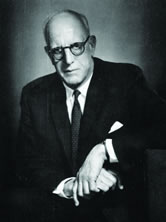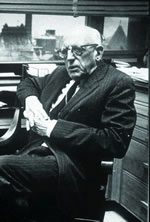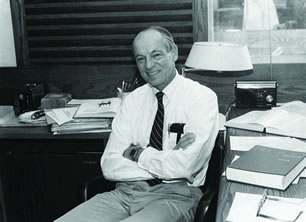William Bosworth Castle
William Bosworth Castle was one of the founding fathers of experimental hematology. His pioneering work on the pathogenesis of pernicious anemia and other red cell disorders was matched by his leadership and mentoring of two generations of academic hematologists.
Castle considered himself fortunate to be "in the right place at the right time." He was richly endowed both by nature and by nurture. His father, William Earnest Castle, was professor of zoology at Harvard and one of the pioneers of mammalian genetics. His younger brother, Edward, was a professor of physiology at Harvard.
Throughout his career, William Castle's prime motivating impetus was to be "a doctor in direct contact with the object of his endeavors: the sick man, woman, or child1 ." His humanitarian impulse forged a strong linkage with an abiding zeal for science. While an intern at Massachusetts General Hospital in 1921, he fell under the spell of George Minot, an exemplar of meticulous clinical investigation who was awarded the Nobel Prize in Medicine for his discovery of liver treatment of pernicious anemia (PA). Minot was a severe diabetic and one of the first patients in Boston to be treated with insulin, giving Castle a first-hand glimpse of the fruits of cutting-edge clinical research.
In 1925, Dr. Francis Weld Peabody recruited Castle to the new Thorndike Memorial Laboratory at Boston City Hospital. It contained one of the nation's first inpatient clinical research wards, staffed by colleagues who "did not forget that the patient was the valued object of their scientific and humanitarian concern2 ." The imprint of Castle's two primary mentors, Minot and Peabody, drove Castle to master the lore and the literature of PA. He wondered why normal individuals did not need to ingest large amounts of liver to stave off the emergence of anemia. In 1929, while riding the elevator in the Thorndike building, he had an epiphany. Since patients with PA were known to lack acidic gastric juice, he concluded that they were unable to adequately digest a nutrient necessary for erythropoiesis. He reasoned that patients with PA lacked an "intrinsic factor" in their stomach required to release an "extrinsic factor" normally present in food. To test this hypothesis he fed himself raw beef and one hour later recovered his gastric juice. He then administered, through a gastric tube, either the gastric juice, raw beef, or a mixture of the two into the stomachs of patients with PA. Only the mixture resulted in a robust reticulocytosis, a sensitive and reliable means of detecting an early hematologic response. These results, buttressed by rigorous controls and extensive refinements, were reported in a series of landmark papers that constituted one of the first applications of hypothesis-driven experimentation to unravel the pathogenesis of a human disease. Nearly 20 years elapsed before cobalamin (vitamin B12) was identified as the extrinsic factor and 40 years before intrinsic factor was shown to be a specific glycoprotein secreted by gastric parietal cells.
In 1931, under the auspices of the Rockefeller Foundation, Castle and Cornelius (Dusty) Rhoads studied large numbers of severely anemic patients in Puerto Rico. Those with macrocytosis, megaloblastic bone marrows, and malabsorption (tropical sprue) responded dramatically to injections of liver extract, later shown to contain both cobalamin and folic acid. They also observed that 90 percent of Puerto Ricans were infected with hookworm, and many of them had severe microcytic anemia. The anemia persisted after purging of the worms but responded to oral iron therapy. Shortly thereafter, Castle and Maurice Strauss showed that in patients with iron deficiency, oral iron was efficiently assimilated, producing a stoichiometric increase in hemoglobin levels.During the 1930s and '40s, hemolytic anemias attracted the attention of Castle and his group of talented junior colleagues at the Thorndike. With Charles "Bud" Emerson, he completed early and informative studies of the red cell defect in hereditary spherocytosis, and with Thomas Hale Ham he provided insight into the pH dependency of in vivo and in vitro hemolysis in paroxysmal nocturnal hemoglobinuria.
The hemolytic disorder that especially piqued Castle's curiosity was sickle cell anemia. In 1940, he and Ham showed that the viscosity of sickle blood increased markedly following exposure to hypoxia. Castle reasoned that oxygen consumption in actively metabolizing tissues could result in obstruction to capillary blood flow, thereby lowering the oxygen tension in neighboring capillaries, inducing further obstruction of flow. Castle's proposal of a "viscous, vicious sickle cycle" continues to be a highly plausible mechanism for acute sporadic episodes of vaso-occlusion. In 1945, during a long train ride, Castle had the opportunity to discuss his ideas on sickle cell disease with Linus Pauling, planting the seed that led to the discovery of a structural abnormality in sickle hemoglobin.
Castle remained active as a teacher at Harvard Medical School and the West Roxbury Veterans Hospital until the early 1980s. He died in 1990 at the age of 923 . Castle's legacy lay in large part in his commanding professional and personal presence. He was a tall, angular man with a deep, resonant voice and steely gaze. He was erudite, curious, articulate, humorous, and humble: a man graced with uncommon magnanimity toward his colleagues, irrespective of seniority. These qualities made him the quintessential professorial role model, one who attracted a legion of devoted disciples, among whom James Jandl was arguably primus inter pares.
James H. Jandl
James H. Jandl was one of the world's premier experimental hematologists and a leading writer of hematology texts. His conduct of science set a standard that informed and inspired a generation of trainees who had the good fortune of working with him. His intellect was as deep as it was broad. He had uncanny insights into underlying biologic mechanisms and, by a combination of reasoning and instinct, could design the experiment most apt to produce a conclusive result.
Jandl received his MD from Harvard Medical School in 1949 and, during his residency at Boston City Hospital, came under the aegis of William Castle, who served as his mentor for the next two decades, playing a critical role in developing and fostering his interest in the red blood cell.
Jandl took full advantage of the wealth of pathology at the Boston City Hospital and focused with laser-like intensity on inherited and acquired disorders of the red blood cell. He began studying patients with alcoholic cirrhosis and published definitive studies on red cell production and survival in chronic liver disease, as well as the impact of cirrhosis on folic acid metabolism. Thirteen years later, he and Richard Cooper showed that, in liver disease, the red cell membrane acquires excess phospholipids and cholesterol, leading to the formation of target-like and spiculated red cells.
Jandl devoted a large portion of his creative energy to studies of hemolytic anemias. In a remarkably thorough and inventive series of studies, he explored the mechanism by which antibody-coated red cells are destroyed in the liver and spleen. He exploited the use of radio-labeled erythrocytes to monitor cell survival and to identify sites of organ sequestration. Subsequently, he and his colleagues demonstrated that antibody-coated red cells attach to macrophages via the immunoglobulin FC receptor, forming flower-like rosettes. The macrophage nibbles at the membrane of adherent red cells, transforming normal biconcave discs into spherocytes. This vivid morphologic observation provided an elegant explanation for the enhanced rigidity of antibody-coated red cells, which contributes importantly to their destruction. In addition, he and his colleagues published definitive studies delineating the fate of free hemoglobin in the plasma and the process by which the kidney handles hemoglobin, as well as identifying organs of uptake.
Jandl made equally important contributions in other types of hemolytic anemia. He and Harry Jacob showed increased cation leak and consequent high glucose consumption in red cells of patients with hereditary spherocytosis, providing a logical explanation for their demise in the unfriendly nutrient-depleted cords of the spleen. Jandl and Jacob also broadened our understanding of the nature of drug-induced oxidant hemolysis in individuals with glucose-6-phosphate dehydrogenase deficiency. Their experiments provided new insights into how oxidant stress can lead to denaturation of hemoglobin within the red cell, resulting in development of rigid inclusion-laden red cells. Jandl's studies of red cell metabolism produced a coherent understanding of the mechanism by which deficiency in specific red cell enzymes, including pyruvate kinase, leads to a shortening of red cell lifespan.
These remarkably insightful and comprehensive studies of the hemolytic anemias were accompanied, and perhaps trumped, by an equally thorough and groundbreaking investigation of the utilization of iron by erythroid cells. Jandl provided the first comprehensive understanding of the entry of iron into erythroid cells through iron transferrin and its binding to specific receptors. He also developed the concept of the "iron transferrin cycle," a process by which this iron-binding protein in the plasma efficiently transports a large amount of iron to the erythropoietic cells in the bone marrow sufficient to accommodate high-level hemoglobin production. These studies were among the very first to recognize the critical importance of receptors for specific biologic transport functions.
This brief summary of Jandl's research accomplishments does not do justice to his stature and leadership in clinical investigation. His trainees learned that scientific truth is a very stern mistress, and that any presumption of discovery must pass the muster of rigorous self-criticism. Jandl conveyed a reverence for the English language, not only in his scholarly writing, but also in his lectures and in informal discussion. His remarkable effectiveness as a mentor came from a synergistic blend of these highly disciplined attributes with great personal magnetism: a delightfully wry sense of humor, a high level of energy, and genuine concern for the welfare of his fellows, residents, and students.
Jandl devoted the remainder of his career to writing three outstanding and widely read books devoted to blood disorders: an atlas, Blood: Atlas and Sourcebook of Hematology; and two single-author works, the concise Blood: Pathophysiology and the comprehensive and scholarly Blood: Textbook of Hematology.
Jandl died on July 17, 2006, after a prolonged illness.





